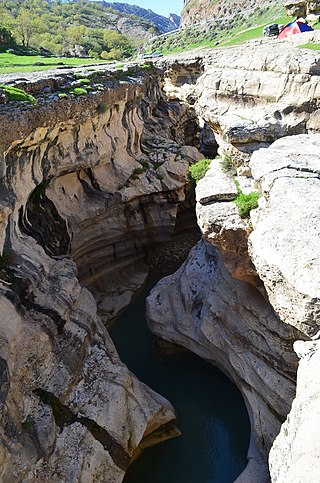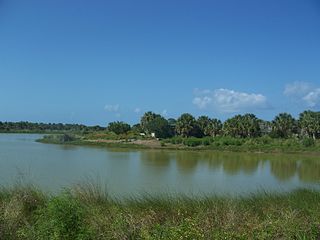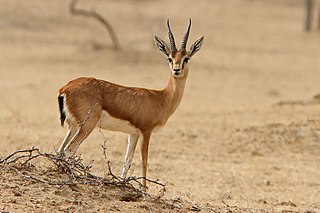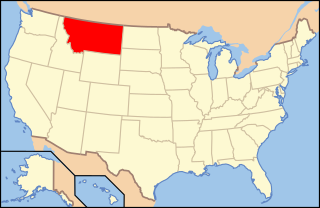
Ilam Province is one of the 31 provinces of Iran. It is located in the western part of the country in Region 4 and covers 20,164.11 km2 (7,785.41 sq mi). It shares 425 km (264 mi) of the border with Iraq, and also bordering on the provinces of Kermanshah, Lorestan, and Khuzestan. The largest city and also the provincial capital is Ilam.

Pelican Island National Wildlife Refuge is a United States National Wildlife Refuge (NWR), and part of the Everglades Headwaters NWR complex, located just off the western coast of North Hutchinson Island in the Indian River Lagoon east of Sebastian, Florida. The refuge consists of a 3-acre (12,000 m2) island that includes an additional 2.5 acres (10,000 m2) of surrounding water and is located off the east coast of Florida of the Indian River Lagoon. Established by an executive order of President Theodore Roosevelt on March 14, 1903, Pelican Island was the first National wildlife refuge in the United States. It was created to protect egrets and other birds from extinction through plume hunting. The oldest government wildlife refuge of any kind in North America is the Lake Merritt Bird Refuge in Oakland, California. Oakland Mayor Samuel Merritt declared it a wildlife refuge for migrating birds in 1869. In 1870, the state of California designated Lake Merritt a state game refuge.

Zibad is a village in, and the capital of, Zibad Rural District, of Kakhk District, Gonabad County, Razavi Khorasan province, Iran.

Dasht-e Kavir or Kavir Desert, also known as Kavir-e Namak or the Great Salt Desert, is a large desert lying in the middle of the Iranian Plateau. It is about 800 kilometres (500 mi) long by 320 kilometres (200 mi) wide with a total surface area of about 77,600 km2 (30,000 sq mi), making it the world's 24th largest desert. The desert stretches from the Alborz mountain range in the north-west to the Dasht-e Lut in the south-east. It is spread across the Iranian provinces of Khorasan, Semnan, Tehran, Isfahan and Yazd.

Alvand is a subrange of the Zagros Mountains in western Iran located 10 km (6.2 mi) south of the city of Hamadan in Hamadan Province. Its summit has an elevation of 3,580 m (11,750 ft). The main body of the Alvand range extends for about 50 km from east to west, while their maximum north-south width is about 30 km. Formed as part of the Zagros orogeny in the late Jurassic and early Cretaceous, the mountains rise sharply from the surrounding plains and are scored by many deep valleys. The mountains are mostly granite and diorite, which are types of intrusive rock.

The chinkara, also known as the Indian gazelle, is a gazelle species native to India, Iran, Afghanistan and Pakistan.

The Upper Mississippi River National Wildlife and Fish Refuge is a 240,000-acre (970 km2), 261-mile long (420 km) National Wildlife Refuge located in and along the Upper Mississippi River. It runs from Wabasha, Minnesota in the north to Rock Island, Illinois in the south.

The Zagros Mountains forest steppe is a temperate broadleaf and mixed forests ecoregion in Western Asia. The ecoregion extends along the Zagros Mountains, stretching from eastern Turkey and northern Iraq to southern Iran.

Kavir National Park is a protected ecological zone in northern Iran. It has an area of 4,000 square kilometers. The park is located 120 kilometers south of Tehran and 100 kilometers east of Qom, and it sits on the western end of the Dasht-e Kavir.

The Archie Carr National Wildlife Refuge is part of the United States National Wildlife Refuge (NWR) System, located along a twenty-mile (30 km) section of coastline from Melbourne Beach to Wabasso Beach, Florida, along State Road A1A. The 900 acre (3.6 km2) refuge was established in 1991, to protect the loggerhead and green sea turtles.

The Lake Wales Ridge National Wildlife Refuge is part of the United States National Wildlife Refuge (NWR) System, located in four separated areas on the Lake Wales Ridge east of US 27 between Davenport and Sebring Florida. The 1,194 acre (4.8 km2) refuge was established in 1990, to protect a host of plants and animals. It is also the first to be designated primarily for the preservation of endangered plants, and is not open to the general public. It contains a high proportion of remaining Florida scrub habitat. It is administered as part of the Merritt Island National Wildlife Refuge.

Darreh Shahr County is in Ilam province, Iran. Its capital is the city of Darreh Shahr.
The wildlife of Iran include the fauna and flora of Iran.

Miyānkāle peninsula is a long, narrow peninsula in Behshahr County of Māzandarān Province in the north of Iran situated in the extreme south-eastern part of the Caspian Sea. The elongate peninsula is 48 kilometres long, and between 1.3 and 3.2 kilometres wide.

The following is an alphabetical list of articles related to the U.S. state of Montana.

The Hyrcanian forests are a zone of lush lowland and montane forests covering about 55,000 square kilometres (21,000 sq mi) near the shores of the Caspian Sea in Iran and Azerbaijan. The forest is named after the ancient region of Hyrcania. The World Wide Fund for Nature refers to the ecoregion as the Caspian Hyrcanian mixed forests. Since 5 July 2019, the Hyrcanian Forests have been designated a UNESCO World Heritage Site. In September 2023, the heritage site expanded to incorporate portions of the forest located in Azerbaijan.
The Iranian Department of Environment is a governmental organization, under the supervision of the president, that is responsible for matters related to safeguarding the environment.

The Central Persian desert basins ecoregion covers the arid steppe and desert basins of central Iran, stretching into northwestern Afghanistan. The ecoregion extends over the Central Iranian Plateau, which is surrounded by mountain ranges and has no outlets to the sea. Much of the terrain is hot sand-and-gravel desert and large salt flats. The vegetation includes many specialized species of halophytes (salt-tolerant), xerophytes (drought-tolerant), and psammophile (sand-loving) plants.
The biosphere reserves of Iran have a total land area of 1.64 million km2. They support more than 8,000 recorded species of plants, 502 species of birds, 164 species of mammals, 209 species of reptiles, and 375 species of butterflies.















